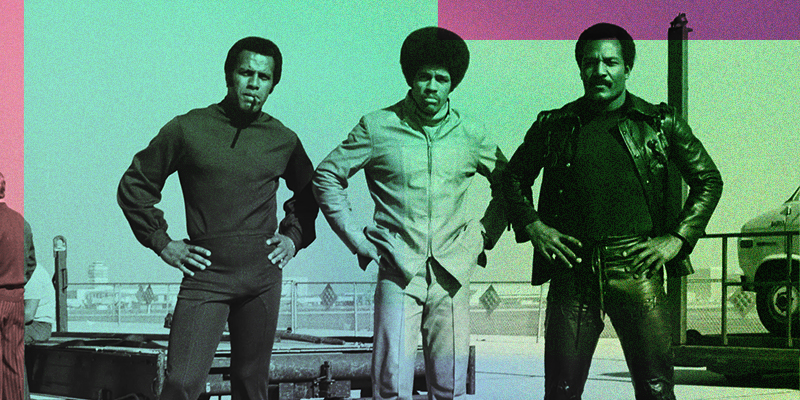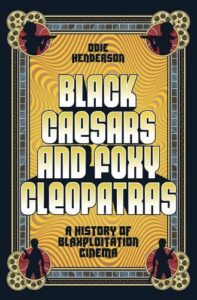“Didn’t you once cause quite a stir by challenging heavyweight boxing champion Muhammad Ali to a fight?” Black Belt magazine asked Jim Kelly in an interview. It was even more unbelievable than that! On December 16, 1973, UPI reported that the stars of the upcoming feature Three the Hard Way—Jim Brown, Fred Williamson, and Kelly—had challenged Ali, George Forman, and Joe Frazier to a fight. This wasn’t a publicity stunt for the still-shooting movie, nor was it a staged event for charity. This appeared to be a good, old-fashioned street challenge, woof tickets being sold to three boxing champions by two former football players and a karate expert.
And what woof tickets they sold! “I just think that we’re as tough as those three dudes,” said Brown, who was being interviewed alongside Williamson and Kelly. “All [the boxers] do is talk about fighting in the ring. But how tough are they out of it?” Perhaps they’d forgotten that Ali came from Kelly’s tough hometown of Louisville, Foreman grew up in Houston’s Fifth Ward, and Frazier was a South Carolina sharecropper’s kid who moved to Philly when he was fifteen.
Brown offered to fight Ali, because in the 1960s, the two sparred in practice. “He wasn’t as strong as I am,” he revealed. Kelly would fight Joe Frazier. “Fred’s got the hardest assignment with Foreman,” said Brown. “But I have no doubt we can handle ’em.”
The fight never happened.
Three the Hard Way did happen, however, becoming the first of three films the trio would make together. Directed by Gordon Parks Jr. and written by Eric Bercovici and Jerrold L. Ludwig, it told the story of a racist plan to put some kind of plague in the water that kills only Black people. There’s some mention of sickle cell anemia to keep things legit. It’s up to the heroes to stop this racist group whose leader looks a lot like Howard Cosell. “It took God seven days to make the earth,” says the head baddie. “It’ll take us three days to cleanse it.” The plot sounds crazy enough, but even more shocking is that the film was shot by veteran cinematographer Lucien Ballard.
In his five-decade career, Ballard worked with some of the greatest directors. Josef von Sternberg used him as a camera operator on 1930’s Morocco, and he got his first cinematography credit working with von Sternberg on Crime and Punishment. Ballard also worked with Henry Hathaway (whose last film was a Blaxploitation quickie called Super Dude), Sam Peckinpah, Stanley Kubrick, and Budd Boetticher. Except for Kubrick, these directors used him multiple times. Three the Hard Way was Parks Jr.’s second collaboration with Ballard, after 1974’s Thomasine and Bushrod, Max Julien’s intriguing take on Bonnie and Clyde. Like Gordon Willis, he was hated by the cinematography branch of the Oscars. Ballard was nominated only once, for a Joan Crawford film called The Caretakers. He shot 130 films in his career, mostly made in the days when there were two chances to be nominated (black & white and color), yet the Academy repeatedly snubbed him. This despite his invention of the Obie, a light he created to hide the facial scars his then wife, Merle Oberon, received in a car accident, and his work with legend Gregg Toland on how best to shoot Jane Russell’s cleavage in Howard Hughes’s The Outlaw.
Three the Hard Way was a fixture on New York City independent channels during the mid-1970s. On TV, it looked like hot garbage and was edited down to a PG-rated version. Comparatively, on the big screen, Ballard’s widescreen compositions and his ability to light different shades of Black skin correctly made the film look better than its budget suggested. Some of it is still too dark to be effective, but the old master still has an impressive trick or two up his sleeve.
That plot about putting Black death in the water supplies of Los Angeles, Washington, D.C., and Detroit is merely an excuse for Kelly, Washington, and Brown to shoot, stab, and karate-chop hundreds of people. Record producer Jimmy Lait (Brown) is in LA producing the soul group who provide the film’s soundtrack, the Impressions. An old friend who was being experimented on by White supremacists escapes from the compound where he was imprisoned. The guy seems delusional, so Jimmy doesn’t believe him. Then his friend is murdered and Jimmy’s main squeeze, Wendy (Sheila Frazier), is kidnapped.
After he barely avoids being killed, Lait heads to Chicago to see his friend, Jagger Daniels (Williamson). The villains try to kill him, too. Sensing that three is a magic number, at least where heroes are concerned, the duo head to New York City to recruit Mister Keyes (Kelly), a sabom who runs a tae kwon do studio. Mister is not an honorific, it’s literally Keyes’s first name.
Keyes is introduced in Kelly’s most famous scene, the one every fan fondly remembers. After crooked cops plant cocaine in the red velvet interior of his car, an angry Mister asks, “Gonna set me up?” Then he dispenses a ridiculous and exciting slow-motion ass kicking on numerous cops, none of whom are quick enough to shoot him. The trio is now complete.
To get some nudity into the picture, Jagger also calls in three dominatrices, one Black, one White, and one Asian, to interrogate a witness. Three the Hard Way is too afraid to show their methods, but whatever they are, they’re fatal. Mister asks for their phone number.
After much violence, the racist evil plan is foiled and Three the Hard Way ends on a freeze frame of an exploding Cadillac, as if the filmmakers suddenly ran out of money. That wouldn’t be a surprise, considering that Allied Artists, the studio that made the film, was once a Poverty Row studio called Monogram back in the days of film noir. The budget was so low that Brown did his own dangerous stunts, the most impressive of which involved using a gun that never needed to be reloaded.
When Three the Hard Way opened at the DeMille in New York City on June 26, 1974, it was universally panned. Donald Mayerson of Cue magazine said, “The plot . . . is simply awful.” The Calgary Herald called it a “comic strip gone berserk” where “several white enemies catch on fire and burn picturesquely to death.” Williamson brushed off the criticism: “Most of my fans are kids in the ghetto areas and they relate to the characters I play.” Those kids weren’t writing reviews, but they were buying tickets. Three the Hard Way opened in eighth place, on its way to making $3 million at the box office, a million-dollar return on its $2 million budget.
___________________________


















